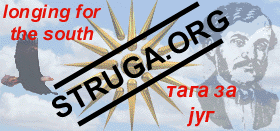
 |
The cave church of St. Archangel Mikhail in Radozhda |
Cave Church "Arhangel Mihail" in Radozda - Protected Value of Lakeshore Sanctuary
(Utrinski Vesnik, 23.07.2004) - In edition of the Republic Bureau for Protection of Cultural Monuments, printed edition accompanied by a CD-ROM entitled "Cave Church 'Arhangel Mihail' - Radozda" has been published. The material offers an opportunity to see the way in which an expert Macedonian team, with foreign financial assistance, has brought back the greatness of the valuable object, exceptional by numerous characteristics, including the location - cave church in a Struga village near the Macedonian-Albanian border.
Project "Research and Conservation of Cave Church Dedicated to Archangel Mihail in Village Radozda" has been realized in cooperation with the world foundation for protection of cultural monuments from New York, and its beginning is linked with the grant from program Kres for protection of European cultural heritage, one from the World Foundation for Protection of Cultural Monuments in 2003, as well as the support from foundation Samuel H. Kres from New York. The project, which was realized in period September 15-November 15, 2003, included the expert team from the Republic Bureau for Protection of Cultural Monuments, Ministry of Culture and the Association for Valorization, Popularization and Pedagogy of Cultural Heritage - Macedonia. The working team was comprised of cultural heritage expert Pance Velkov, project manager/conservationist-advisor/art historian, Donka Barcieva Trajkovska, as well as members of research-conservation team: architect/senior conservationist Snezana Gerasimova-Matevska, academic sculptor/councilor conservationist Dragi Vergovski, senior conservationist Vasil Trajkovski, and painter-conservationist/collaborator Ilija Gjoreski, along with several external collaborators of the Republic Bureau for Protection of Cultural Monuments, Makedonida and other institutions.
"The cave church dedicated to Archangel Mihail is located high on the rocks, in an inaccessible, but exceptionally picturesque area over village Radozda at the Ohrid Lake. Based on the configuration of the terrain and the numerous caves at several levels around the temple, one can conclude that it is a monastery church, which history has been followed from the end of the 18th until the 19th century", Donka Bardzieva-Trajkovska says, who refers to the preserved construction and painting stages of the church, stressing that they enable a reconstruction of the sanctuary's history. According to her, the sanctuary had been probably established "by a monk, who built the church. As common in Orthodox tradition, the temple afterwards gathered other monks, thus establishing a monastic brotherhood with over 40 monks. The monastic brotherhood was active until the end of 17th century". The last reconstruction was done by mid-19th century (1840) by Krste Sekulov, who financed the construction of the iconostasis and the cross, made by icon painter Jakov Radev from village Lazaropole. The church today is an object comprised of a narthex and naos, oriented in direction south-north. One can enter the church through the only entrance set at the north wall.
The church's icon paintings have four chronological stages. The oldest icon painting is linked to the original building, dating by the end of the 13th century. New mortar had been set over it in the 14th century, while the icon paintings in today's naos date from the 15th century. New mortar with new icon paintings had been put at the eastern and northern walls in the narthex by the end of the 16th or beginning of the 17th century, while the other walls of the narthex have icon paintings from the 14th century.
In the presentation of the completed research-conservatory projects, there is special emphasis on the preparation of the documentation of the existing condition of the cave church, along with research activities of the building and the fresco art, as well as photo documentation of the specific research activities of the icon paintings.
The second stage included realization of initial conservation-restoration works at the fresco-art and architecture. The volume and type of conservation activities has been determined based on the success of results acquired from the trial research for cleaning of the icon paintings from the deposits.
The second stage of the project also included construction of a preventive roof of the church, preventive protection of certain critical parts of the building, along with preventive protection of the icon paintings from the 14th century in the narthex.